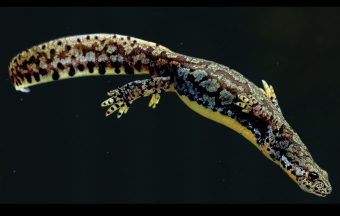On the plateau of Mount Vranica, in the heart of Bosnia and Herzegovina, lies Prokoško Lake – a natural jewel of exceptional biological value. In the cold, clear waters of this mountain lake and its surroundings, a unique amphibian species has survived for centuries – the Bosnian alpine newt (Ichthyosaura alpestris reiseri). This special subspecies of the alpine newt lives nowhere else in the world, making it a true natural rarity. As a post-glacial relict, it survived the last Ice Age precisely in this area and represents the only true stenoendemic amphibian in Bosnia and Herzegovina.
However, due to human influence, this species is now endangered. What extreme weather conditions failed to accomplish, humans did in the late 1960s, when an invasive predatory fish – rainbow trout (Oncorhynchus mykiss) – was introduced into Prokoško Lake. Its presence caused a drastic decline in the newt population, and the subsequent introduction of additional fish species in recent years led to its complete disappearance.

Today, a team of experts and young biologists gathered around the National Museum of Bosnia and Herzegovina is dedicated to protecting the Bosnian alpine newt and its natural habitat. We spoke with herpetologist Adnan Zimić, project leader and one of the most knowledgeable experts, about its significance and the ongoing conservation efforts.
Prokoško Lake is the site where this subspecies was first scientifically described, but today it no longer has a stable population there, which, as Zimić emphasizes, is particularly sad. Although individual specimens occasionally appear, they fail to establish a sustainable population due to the presence of invasive fish.
Climate change further worsens the situation by accelerating the eutrophication of water bodies, while fungal diseases affecting amphibians worldwide also pose a threat. Nevertheless, invasive fish remain the main problem.
The Bosnian alpine newt differs from other alpine newts by its more robust build and more prominent head. Although relatively little is known about its biology, it plays an important role in the ecosystem – particularly in regulating invertebrate populations – making it an indicator of healthy aquatic habitats.
IN FOCUS:
- Fluo Varoš 1 and 2 – Construction Begins on Two Modern Solar Power Plants in Aleksinac
- WWF Expands a Network Of Hope – From Vienna To The Danube, From Schools To Forests
- How ABB Technology Redefines Industrial Energy Efficiency
Conservation of the Bosnian Alpine Newt
The conservation team has been formed around the project of the National Museum of BiH, with the participation of biology students from the Faculty of Science, University of Sarajevo, and members of the Herpetological Association ATRA. Through joint field activities, students acquire practical knowledge in monitoring and conservation biology. At the same time, the entire team works on mapping potential habitats and restoring aquatic areas that newts use throughout the year.
The activities were launched through a UNDP project on the sustainability of protected areas, in cooperation with the public utility company Šćona. During 2023, aquatic habitats were restored at two sites – Zavol and Šestica – where hibernacula (overwintering shelters for newts) were also built. At the same time, regular population monitoring and mapping of new sites around Prokoško Lake are being carried out.
An ex situ unit has also been established at the National Museum – a specially arranged space where individuals are kept and bred under controlled conditions. This population serves as the basis for future reintroduction, should the conditions allow it.
Experts emphasize that without the removal of invasive fish species from Prokoško Lake, the Bosnian alpine newt will not be able to survive in its original habitat. The process of fish eradication is complex but crucial for the recovery of this endangered species.
A Broader Perspective: The State of Other Amphibians and Reptiles in BiH
Zimić warns that amphibians and reptiles are among the most endangered vertebrates in Bosnia and Herzegovina. Habitat loss, pollution, climate change, and invasive species threaten their populations. Many species are tied to specific and sensitive microhabitats, such as small ponds, which are easily disrupted.
Amphibians are particularly vulnerable due to their thin, permeable skin, which they use partly for respiration, making them sensitive to pollution, drought, and changes in temperature and humidity. In BiH, all species of tailed amphibians, many frog species, all turtle species, and a large number of snakes are endangered. Each faces specific threats and requires special attention.
As our interviewee concluded, helping these species requires the preservation and restoration of habitats, a ban on the introduction of foreign species, and raising awareness among the local population.
Prepared by Katarina Vuinac
The story was published in Energy portal Magazine CLIMATE CHANGE

